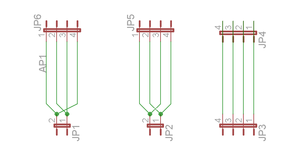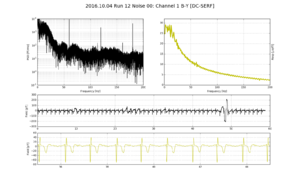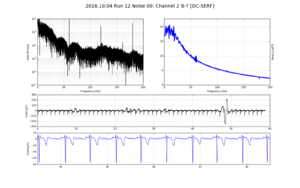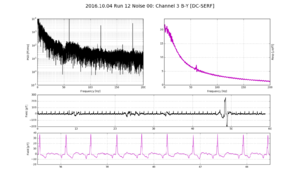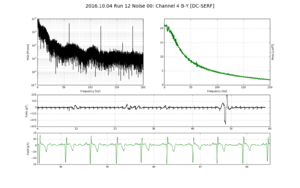Lena/Oct 2016: Difference between revisions
ElenaZhivun (talk | contribs) |
ElenaZhivun (talk | contribs) |
||
| Line 48: | Line 48: | ||
Zach made an adult measurement with all four channels running. |
Zach made an adult measurement with all four channels running. |
||
=== DC run 1 === |
|||
==== Channel 1 ==== |
|||
[[File:MagRun3 2016.10.04 R12N00 Chan1Y.png|300px]] |
|||
==== Channel 2 ==== |
|||
[[File:MagRun3 2016.10.04 R12N00 Chan2Y.png|300px]] |
|||
==== Channel 3 ==== |
|||
[[File:MagRun3 2016.10.04 R12N00 Chan3Y.png|300px]] |
|||
==== Channel 4 ==== |
|||
[[File:MagRun3 2016.10.04 R12N00 Chan4Y.png|300px]] |
|||
=== DC run 2 === |
|||
=== Z mode run 1 === |
|||
=== Z mode run 2 === |
|||
== 10/12/2016 == |
== 10/12/2016 == |
||
Revision as of 15:02, 13 October 2016
October 2016
BACK/NEXT
10/03/2016
fMCG setup TODO
- Feedback system to keep the fields from "running away". Only the main XYZ fields need to be stabilized, the gradients don't change much day to day
- Reduce the polarimeter noise when misbalanced
Eliminating polarimeter noise when misbalanced
The existing current amplifier consists of two photodiodes connected in a way to add or subtract their photocurrents. The output of this passive circuit is connected to an SR570 current preamplifier.
I want to replace this circuit with something that can output both sum and difference, so that the common mode variations can be cancelled. Apparently a circuit that is supposed to do that has already been designed (see the link). The circuit has very little documentation and needs to be modified to increase the gain. We need 1-2 μA/V on the differential channel and 100-200 μA/V on the sum channel.
10/06/2016
New photodetector
Started on the new photodetector design and prototype here.
Lab meeting
Quick division
FPGA has hard times dividing numbers. Matt mentioned that there is an algorithm that quickly inverts any int32 number by multiplying it with a "magic number". https://en.wikipedia.org/wiki/Fast_inverse_square_root Never mind, it's for the floating point numbers.
fMCG setup field stabilization
Zack and Mike tried to stabilize the field in the magnetically shielded room by controlling the room coils with a feedback look (Y direction only). They tried the fluxgate, but it's sensitivity is not enough, as the polarization rotation signal is going offscreen. The stabilization system works well when the magnetometer signal on the Y channel is used for the feedback control. The bandwidth of the feedback is DC-0.5 Hz. The only problem is that when the sensor is tilted it doesn't work as well.
Shot noise limit for 10 USD
Thad mentioned there is an article by Hobbs titled "Reaching the shot noise limit for $10". File:Shotnoise opn.pdf
Downsample the magnetometer signal to 1 kHz
Zach mentioned that all the existing post-processing software expects the data to be sampled at 1 kHz. Right now it's at 20 kHz, and it's causing problems.
10/10/2016
Zach made an adult measurement with all four channels running.
DC run 1
Channel 1
Channel 2
Channel 3
Channel 4
DC run 2
Z mode run 1
Z mode run 2
10/12/2016
Expanding the number of channels
Discrepancy between the expected and measured DAQ noise
It seems like the noise we are measuring is somewhat lower than what our bit depth suggests.
Adding an anti-aliasing filter to the polarimeter
In order to run the data acquisition at a smaller rate, we can place a hardware anti-aliasing filter on the differential polarimeter boards. This would take the computational load off the digital system and relax the requirements on how fast we acquire the data.
